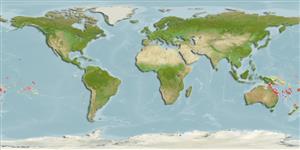>
Blenniiformes (Blennies) >
Tripterygiidae (Triplefin blennies) > Tripterygiinae
Etymology: Enneapterygius: Greek, ennea = nine times + Greek, pterygion = little fin (Ref. 45335).
More on author: Waite.
Environment: milieu / climate zone / depth range / distribution range
Ecologia
marinhas associadas(os) a recifes; não migratória; intervalo de profundidade 0 - 6 m (Ref. 13227). Subtropical
Southwest Pacific: Australia, New Caledonia (including the Loyalty Islands), Fiji, and Tonga. Records of this species from the Kermadec Islands (Ref. 8879) are based on Enneapterygius kermadecensis.
Tamanho / Peso / Idade
Maturity: Lm ? range ? - ? cm
Max length : 4.5 cm SL macho/indeterminado; (Ref. 54980)
Descrição suscinta
Chaves de identificação | Morfologia | Morfometria
Espinhos dorsais (total) : 13 - 17; Raios dorsais (total) : 8 - 12; Espinhos anais: 1; Raios anais : 16 - 21. Small supraorbital tentacle; first dorsal fin in females shorter by 50% than second dorsal fin; in males, shorter by 25%; body translucent gray in both sexes, edges of scales varying from pink to dark reddish brown, the pink-edged scales forming blotches along back; caudal fin base bearing a white bar; top of head red; female head brown and cheek with small white spots, red lower and posterior upper lip; lower part of male head black with exception of lower lip to end of maxilla being bright red and upper part of opercle red. Dorsal rays III + X-XIV + 8-12; lateral line interrupted, 15-20 + 15-21; mandibular pores 4 + 1 + 4 (Ref. 54980).
Adults are found in shallow water and tidal pools (Ref. 13227). They feed on gastropods (Ref. 94105). Eggs are hemispherical and covered with numerous sticky threads that anchor them in the algae on the nesting sites (Ref. 240). Larvae are planktonic which occur primarily in shallow, nearshore waters (Ref. 94114).
Ciclo de vida ou comportamento de acasalamento
Maturities | Reprodução | Spawnings | Egg(s) | Fecundities | Larvas
Fricke, R., 1994. Tripterygiid fishes of Australia, New Zealand and the southwest Pacific Ocean (Teleostei). Theses Zool. 24:1-585. (Ref. 13227)
Status na Lista Vermelha da UICN (Ref. 130435)
Ameaça para os humanos
Harmless
Uso pelos humanos
Pescarias: sem interesse
Ferramentas
Relatórios especiais
Baixar XML
Fontes da internet
Estimates based on models
Preferred temperature (Ref.
123201): 21.5 - 28.1, mean 26.4 °C (based on 412 cells).
Índice de diversidade filogenética (Ref.
82804): PD
50 = 0.5000 [Uniqueness, from 0.5 = low to 2.0 = high].
Bayesian length-weight: a=0.00562 (0.00258 - 0.01228), b=3.08 (2.89 - 3.27), in cm total length, based on LWR estimates for this (Sub)family-body shape (Ref.
93245).
Nível Trófico (Ref.
69278): 3.2 ±0.3 se; based on size and trophs of closest relatives
Resiliência (Ref.
120179): Elevada, tempo mínimo de duplicação da população menor que 15 meses (Preliminary K or Fecundity.).
Fishing Vulnerability (Ref.
59153): Low vulnerability (10 of 100).
Nutrients (Ref.
124155): Calcium = 270 [97, 807] mg/100g; Iron = 1.85 [0.71, 4.20] mg/100g; Protein = 19.1 [17.5, 20.7] %; Omega3 = 0.141 [0.043, 0.456] g/100g; Selenium = 17.5 [4.2, 61.6] μg/100g; VitaminA = 35.7 [5.9, 237.9] μg/100g; Zinc = 2.8 [1.3, 5.2] mg/100g (wet weight);
